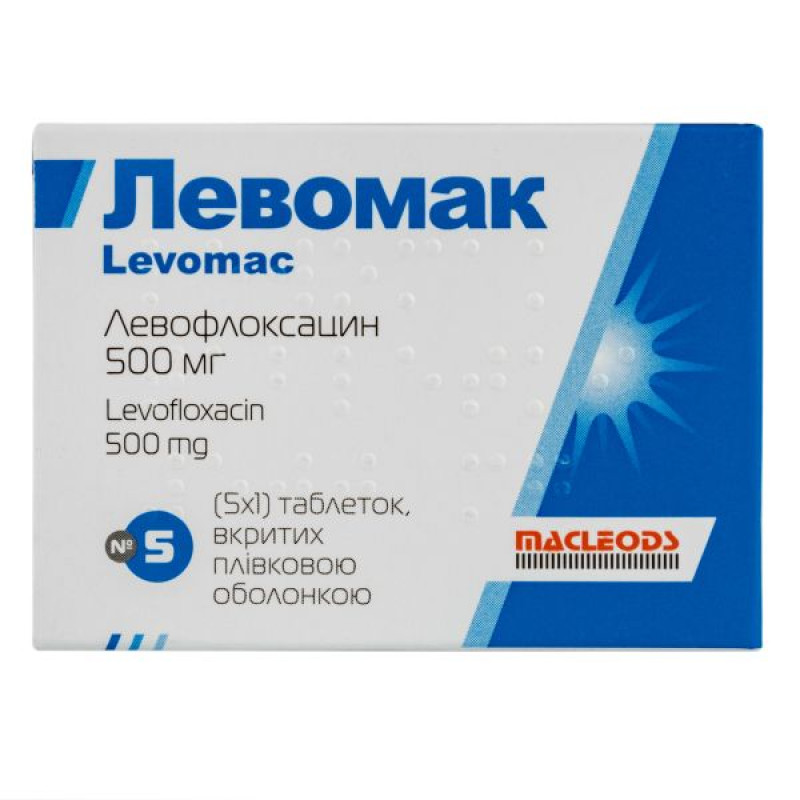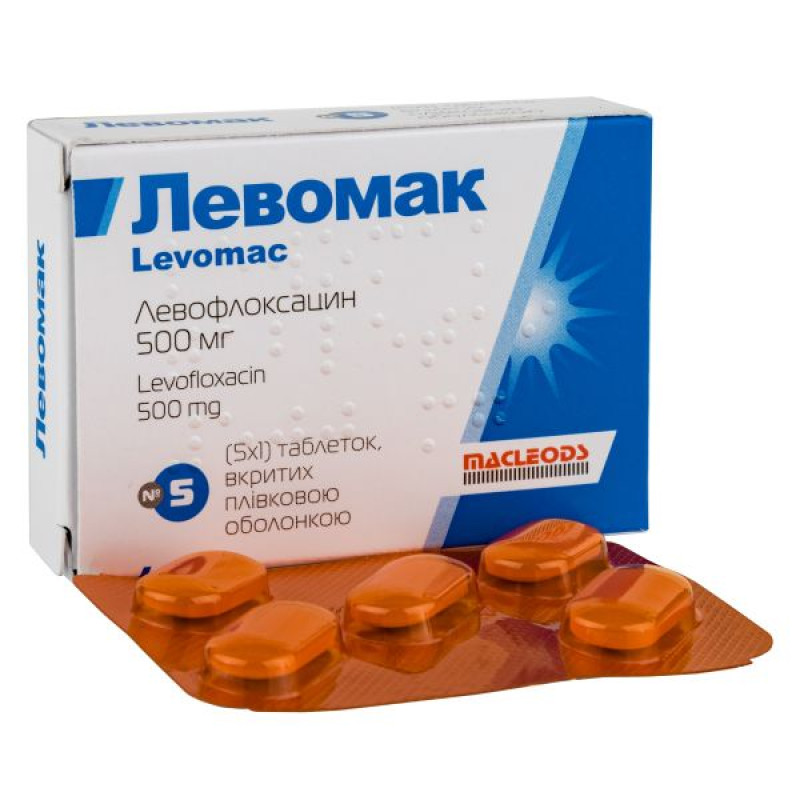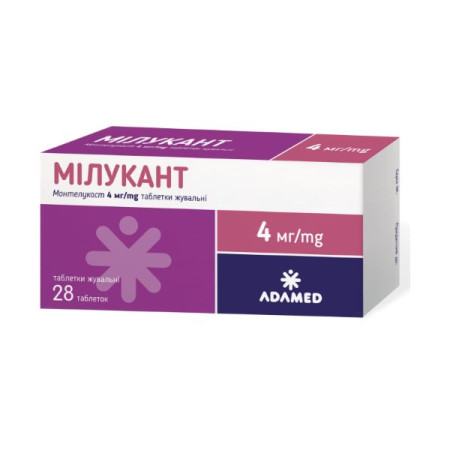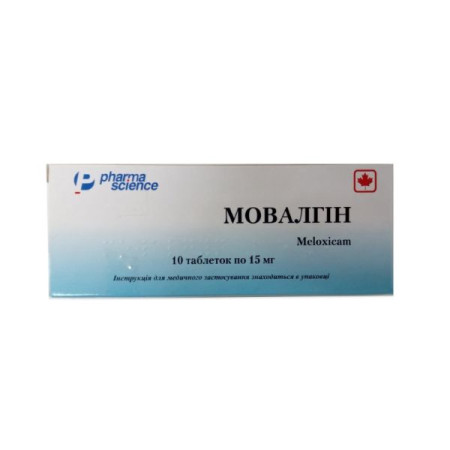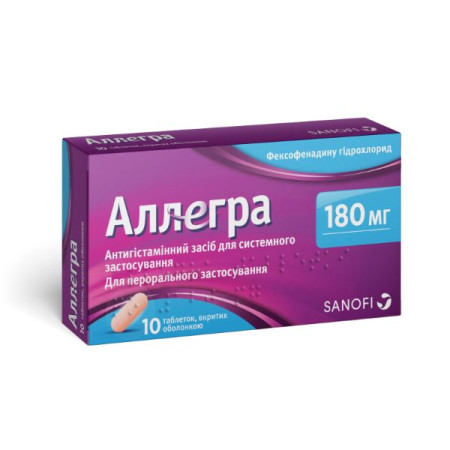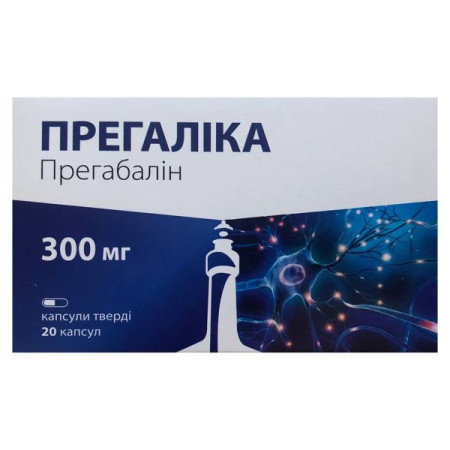Levomac film-coated tablets 500 mg No. 5
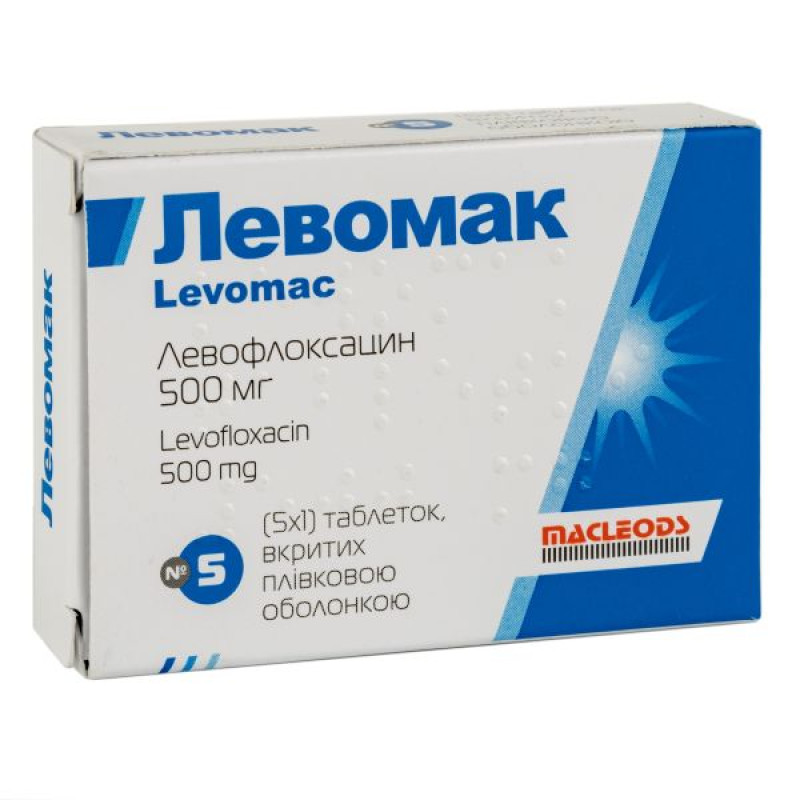
Instructions for Levomac film-coated tablets 500 mg No. 5
Composition
active ingredient: levofloxacin;
1 tablet contains levofloxacin hemihydrate equivalent to levofloxacin 250 mg or 500 mg;
Excipients: microcrystalline cellulose, pregelatinized starch, polysorbate 80, crospovidone, talc, colloidal anhydrous silica, magnesium stearate, hydroxypropylmethylcellulose, titanium dioxide (E 171), red iron oxide (E 172), yellow iron oxide (E 172), propylene glycol, diethyl phthalate.
Dosage form
Film-coated tablets.
Main physicochemical properties: round, biconvex tablets, film-coated, brown-red in color, smooth on both sides (250 mg);
Capsule-shaped, biconvex, film-coated tablets, brown-red in color, smooth on both sides (500 mg).
Pharmacotherapeutic group
Antibacterials for systemic use. Fluoroquinolones.
ATX code J01M A12.
Pharmacological properties
Pharmacodynamics.
Levofloxacin is a synthetic antibacterial agent from the fluoroquinolone group, the S-enantiomer of the racemic mixture of the drug ofloxacin.
Mechanism of action
As an antibacterial drug from the fluoroquinolone group, levofloxacin acts on the DNA-DNA gyrase complex and topoisomerase IV.
Pharmacokinetics/pharmacodynamics relationship
The degree of bactericidal activity of levofloxacin depends on the ratio of the maximum serum concentration (Cmax) or the area under the pharmacokinetic curve (AUC) and the minimum inhibitory concentration (MIC).
Mechanism of resistance
The main mechanism of resistance is due to mutations in the gyr-A genes. In vitro, there is cross-resistance between levofloxacin and other fluoroquinolones.
Due to its mechanism of action, there is usually no cross-resistance between levofloxacin and other classes of antibacterial agents.
Limit values
The MIC breakpoints recommended by the European Committee on Antimicrobial Susceptibility Testing (EUCAST) for levofloxacin, which distinguish susceptible from intermediately susceptible (moderately resistant) organisms and intermediately susceptible from resistant organisms, are listed in the MIC testing table below (mg/L).
EUCAST clinical MIC breakpoints for levofloxacin (version 2.0, 2012-01-01):
| Pathogen | Sensitive | Resistant |
| Enterobacteriaceae | ≤ 1 mg/l | > 2 mg/l |
| Pseudomonas spp. | ≤ 1 mg/l | > 2 mg/l |
| Acinetobacter spp. | ≤ 1 mg/l | > 2 mg/l |
| Staphylococcus spp. | ≤ 1 mg/l | > 2 mg/l |
| Streptococcus pneumoniae1 | ≤ 2 mg/l | > 2 mg/l |
| Streptococcus A, B, C, G | ≤ 1 mg/l | > 2 mg/l |
| Haemophilus influenzae2,3 | ≤ 1 mg/l | > 1 mg/l |
| Moraxella catarrhalis3 | ≤ 1 mg/l | > 1 mg/l |
| Control points not related to species4 | ≤ 1 mg/l | > 2 mg/l |
1. Levofloxacin checkpoints refer to high-dose treatment. 2. Low-level resistance to fluoroquinolones (ciprofloxacin MIC 0.12–0.5 mg/L) may occur, but there is no evidence of clinical significance of this resistance for respiratory tract infections caused by Haemophilus influenzae. 3. Strains with MIC values above the susceptibility breakpoint are very rare or have not yet been reported. Identification and antimicrobial susceptibility testing on any such isolate should be repeated and, if confirmed, the isolate should be sent to an appropriate laboratory. Until a clinical response is demonstrated for confirmed isolates with MICs above the current resistance breakpoint, they should be reported as resistant. 4. Checkpoints apply to oral doses of 500 mg × 1 to 500 mg × 2 and intravenous doses of 500 mg × 1 to 500 mg × 2. | ||
The prevalence of resistance may vary geographically and over time for individual species and it is advisable to obtain local information on the resistance patterns of microorganisms, particularly when treating severe infections. As necessary, specialist advice should be sought when the local prevalence of resistance is such that the benefit of the agent, at least in some types of infections, is questionable.
Typically sensitive species Aerobic Gram-positive bacteria: Bacillus anthracis, methicillin-sensitive Staphylococcus aureus, Staphylococcus saprophyticus, Streptococci groups C and G, Streptococcus agalactiae, Streptococcus pneumoniae, Streptococcus pyogenes. Aerobic gram-negative bacteria: Eikenella corrodens, Haemophilus influenzae, Haemophilus para-influenzae, Klebsiella oxytoca, Moraxella catarrhalis, Pasteurella multocida, Proteus vulgaris, Providencia rettgeri. Anaerobic bacteria: Peptostreptococcus. Others: Chlamydophila pneumoniae, Chlamydophila psittaci, Chlamidia trachomatis, Legionella pneumophila, Mycoplasma pneumoniae, Mycoplasma hominis, Ureaplasma urealyticum. Species for which acquired resistance may be a problem Aerobic Gram-positive bacteria: Enterococcus faecalis, methicillin-resistant Staphylococcus aureus*, coagulase-negative Staphylococcus spp. Aerobic gram-negative bacteria: Acinetobacter baumannii, Citrobacter freundii, Enterobacter aerogenes, Enterobacter cloacae, Escherichia coli, Klebsiella pneumoniae, Morganella morganii, Proteus mirabilis, Providencia stuartii, Pseudomonas aeruginosa, Serratia marcescens. Anaerobic bacteria: Bacteroides fragilis. Naturally resistant strains Aerobic Gram-positive bacteria: Enterococcus faecium. | |||||
| Creatinine clearance (ml/min) | < 20 | 20–49 | 50–80 |
| Renal clearance (ml/min) | 13 | 26 | 57 |
| Half-life (hours) | 35 | 27 | 9 |
Elderly patients: There are no significant differences in the pharmacokinetics of levofloxacin between young and elderly patients, except for differences related to creatinine clearance.
Gender differences: A separate analysis of male and female patients demonstrated slight gender differences in the pharmacokinetics of levofloxacin. There is no evidence that these gender differences are clinically relevant.
Indication
The drug is prescribed to adults for the treatment of the following infections: • Acute bacterial sinusitis. • Exacerbation of chronic bronchitis. • Community-acquired pneumonia. • Complicated skin and soft tissue infections. In the above infections, the drug should be used only when it is considered inappropriate to use antibacterial drugs that are usually recommended for the initial treatment of these infections. • Pyelonephritis and complicated urinary tract infections. • Chronic bacterial prostatitis. • Uncomplicated cystitis. The drug can also be used to complete the course of therapy in patients who have shown improvement during initial treatment with levofloxacin intravenously. Official recommendations on the appropriate use of antibacterial drugs should be taken into account.
Contraindication
Hypersensitivity to levofloxacin or other quinolones, to any component of the drug, epilepsy, complaints of adverse reactions from the tendons after previous use of fluoroquinolones.
Interaction with other medicinal products and other types of interactions
Effect of other medicines on the drug
Iron salts, zinc salts, magnesium and aluminum-containing antacids, didanosine. Levofloxacin absorption is significantly reduced when iron salts or magnesium- or aluminum-containing antacids or didanosine (only for formulations containing aluminum or magnesium buffering agents) are taken simultaneously. Concomitant use of fluoroquinolones with zinc-containing multivitamins reduces their oral absorption. It is not recommended to take drugs containing divalent or trivalent cations, such as iron salts, zinc salts, magnesium or aluminum-containing antacids, or didanosine (only for formulations of didanosine containing aluminum or magnesium buffering agents), within 2 hours before/after levofloxacin administration. Calcium salts had minimal effect on the oral absorption of levofloxacin.
Sucralfate
The bioavailability of levofloxacin tablets is significantly reduced when the drug is used concomitantly with sucralfate. If the patient needs to receive both sucralfate and levofloxacin, it is preferable to take sucralfate 2 hours after taking levofloxacin (see section "Method of administration and dosage").
No pharmacokinetic interaction of levofloxacin with theophylline has been observed. However, a significant decrease in the seizure threshold may occur when quinolones are administered concomitantly with theophylline and nonsteroidal anti-inflammatory drugs and other agents that lower the seizure threshold. Levofloxacin concentrations in the presence of fenbufen were approximately 13% higher than when levofloxacin was administered alone.
Probenecid and cimetidine
Probenecid and cimetidine have a statistically significant effect on the elimination of levofloxacin.
The renal clearance of levofloxacin is reduced by 24% in the presence of cimetidine and by 34% in the presence of probenecid. This is because both drugs are capable of blocking the tubular secretion of levofloxacin. However, at the doses tested in the study, it is unlikely that the statistically significant kinetic differences were of clinical relevance. Caution should be exercised when levofloxacin is co-administered with drugs that affect tubular secretion, such as probenecid and cimetidine, especially in patients with renal impairment.
Other
Calcium carbonate, digoxin, glibenclamide, and ranitidine do not have any clinically significant effect on the pharmacokinetics of levofloxacin when used concomitantly.
Effect of the drug on other medicines
Cyclosporine
The half-life of cyclosporine increases by 33% when co-administered with levofloxacin.
Vitamin K antagonists
When used concomitantly with vitamin K antagonists (e.g. warfarin), increases in coagulation tests (PT/international normalized ratio) and/or bleeding, which may be severe, have been reported. Therefore, coagulation parameters should be monitored in patients receiving concomitant vitamin K antagonists (see section 4.4).
Drugs that prolong the QT interval
Levofloxacin, like other fluoroquinolones, should be used with caution in patients receiving medicinal products known to prolong the QT interval (e.g. class IA and III antiarrhythmics, tricyclic antidepressants and macrolides, antipsychotics) (see section 4.4 (QT prolongation)).
Other forms of interaction
Eating
No clinically significant interaction with food has been observed. Levofloxacin tablets can therefore be taken without regard to meals.
Application features
Methicillin-resistant Staphylococcus aureus (MRSA) has a very high potential for cross-resistance to fluoroquinolones, including levofloxacin. Therefore, levofloxacin is not recommended for the treatment of infections known or suspected to be caused by MRSA unless laboratory testing has confirmed susceptibility of the pathogen to levofloxacin.
Levofloxacin can be used to treat acute bacterial sinusitis and exacerbation of chronic bronchitis, if these infections have been appropriately diagnosed.
Fluoroquinolone resistance in Escherichia coli (the most common cause of urinary tract infections) varies between countries. The local prevalence of fluoroquinolone resistance in Escherichia coli should be taken into account when prescribing fluoroquinolones.
Tendinitis and tendon rupture.
Tendinitis, which may lead to tendon rupture, including Achilles tendon, may occur with quinolone treatment. Tendinitis and tendon rupture, sometimes bilateral, may occur within 48 hours of levofloxacin administration and even several months after discontinuation of levofloxacin. Patients over 60 years of age, patients receiving daily doses of 1000 mg levofloxacin, and those receiving corticosteroids are most susceptible to tendinitis and tendon rupture. The daily dose should be adjusted for elderly patients, taking into account creatinine clearance. Therefore, elderly patients should be monitored when levofloxacin is prescribed. If tendinitis is suspected, levofloxacin treatment should be discontinued immediately and appropriate treatment should be initiated (e.g. by ensuring tendon immobilization).
Diseases caused by Clostridium difficile.
Diarrhea, particularly severe, persistent or bloody during or after treatment (including several weeks after treatment) with levofloxacin may be a symptom of Clostridium difficile-associated disease, the most severe form of which is pseudomembranous colitis. If pseudomembranous colitis is suspected, levofloxacin should be discontinued immediately and symptomatic and specific treatment (e.g. vancomycin) should be initiated without delay. In such a situation, drugs that inhibit intestinal peristalsis are contraindicated.
Patients with a tendency to seizures.
Quinolones may lower the seizure threshold and provoke the development of seizures. Levofloxacin is contraindicated in patients with a history of epilepsy.
Glucose-6-phosphate dehydrogenase deficiency.
Patients with latent or active glucose-6-phosphate dehydrogenase deficiency may be predisposed to hemolytic reactions when treated with quinolone antibacterial agents. Therefore, levofloxacin should be used with caution in such patients.
Kidney failure.
Levofloxacin is excreted mainly by the kidneys, therefore dose adjustment is required for patients with renal insufficiency.
Hypersensitivity reactions.
Levofloxacin may occasionally cause serious, potentially fatal hypersensitivity reactions (including angioedema, anaphylactic shock), even after the first administration. If hypersensitivity reactions occur, levofloxacin should be discontinued, a doctor should be consulted and appropriate treatment should be initiated.
Severe bullous reactions.
Severe bullous reactions, such as Stevens-Johnson syndrome and toxic epidermal necrolysis, have been reported with levofloxacin. If bullous reactions occur, levofloxacin should be discontinued immediately, a doctor should be consulted and appropriate treatment should be initiated.
Change in blood glucose levels.
Changes in blood glucose levels (both hyperglycemia and hypoglycemia) have been reported with the use of quinolones, especially in diabetic patients receiving concomitant oral hypoglycemic agents (including glibenclamide) or insulin. Cases of hypoglycemic coma have been reported. Blood sugar levels should be monitored in diabetic patients.
Prevention of photosensitivity reactions.
Photosensitivity reactions have been reported during treatment with levofloxacin.
To prevent photosensitivity reactions, patients taking levofloxacin should avoid sunlight and UV rays (artificial ultraviolet lamps, solariums) due to possible photosensitivity while taking levofloxacin or for 48 hours after stopping levofloxacin.
Patients taking vitamin K antagonists should have their blood clotting parameters monitored when levofloxacin and vitamin K antagonists (warfarin) are co-administered due to the potential risk of increased blood clotting parameters (prothrombin time/INR) and/or bleeding.
Psychotic reactions.
Psychotic reactions have been reported in patients receiving quinolines, including levofloxacin. In rare cases, these have resulted in suicidal ideation and self-harming behaviour, sometimes even after a single dose of levofloxacin. If a patient experiences these reactions, levofloxacin should be discontinued and appropriate measures should be taken. Levofloxacin should be used with caution in patients with psychotic disorders or a history of psychiatric illness.
QT prolongation.
Cases of QT prolongation have been reported with fluoroquinolones. Caution should be exercised when administering fluoroquinolones, including levofloxacin, to patients with known risk factors for QT prolongation:
congenital or acquired long QT syndrome;
with simultaneous use of drugs that prolong the QT interval (including class IA and III antiarrhythmics, tricyclic antidepressants, macrolides, antipsychotic drugs);
in case of electrolyte imbalance (including hypokalemia, hypomagnesemia);
heart disease (heart failure, myocardial infarction, bradycardia).
Elderly patients and women are more sensitive to drugs that prolong the QT interval. Therefore, fluoroquinolones, including levofloxacin, should be used with caution in this group of patients.
Peripheral neuropathy.
Cases of sensory or sensorimotor peripheral neuropathy, which may be rapid in onset, have been reported in patients receiving fluoroquinolones, including levofloxacin. Levofloxacin should be discontinued if a patient develops symptoms of neuropathy to prevent the development of an irreversible condition.
Hepatobiliary disorders.
Cases of hepatic necrosis up to life-threatening hepatic failure have been reported with levofloxacin, predominantly in patients with severe underlying diseases such as sepsis (see section 4.8). Patients should be advised to discontinue treatment and contact their physician if signs and symptoms of liver disease such as anorexia, jaundice, dark urine, pruritus or abdominal pain occur.
Myasthenia gravis
Fluoroquinolones, including levofloxacin, block neuromuscular transmission and may cause muscle weakness in patients with myasthenia gravis. Serious adverse reactions, including fatalities and the need for respiratory support, have been reported post-marketing with fluoroquinolones in patients with myasthenia gravis. Levofloxacin is not recommended for use in patients with a history of myasthenia gravis.
Vision disorders.
If visual impairment or other effects on the eyes are observed, an ophthalmologist should be consulted immediately (see sections “Adverse reactions”, “Ability to influence the reaction speed when driving vehicles or other mechanisms”).
When using levofloxacin, especially long-term, the development of opportunistic infections and the growth of resistant microorganisms is possible. If a secondary infection develops, appropriate measures should be taken.
Laboratory studies.
In patients treated with levofloxacin, urine opiates may give false-positive results. It may be necessary to confirm positive results for opiates using specific methods.
Levofloxacin inhibits the growth of Mycobacterium tuberculosis and therefore may cause false-negative results in bacteriological tests in patients with tuberculosis.
Use during pregnancy or breastfeeding
Pregnancy: There are limited data from the use of levofloxacin in pregnant women.
Animal studies do not indicate direct or indirect harmful effects with respect to reproductive toxicity. However, in the absence of human studies and based on experimental data indicating a risk of damage to the articular cartilage of the growing organism by fluoroquinolones, levofloxacin should not be administered to pregnant women.
Breastfeeding. Levofloxacin is contraindicated in women who are breastfeeding. There is insufficient information on the excretion of levofloxacin in breast milk, although other fluoroquinolones are excreted in breast milk. Due to the lack of human studies and the potential for fluoroquinolones to damage the articular cartilage of the growing fetus, levofloxacin should not be administered to women who are breastfeeding.
Fertility: Levofloxacin is known to have no effect on fertility or reproductive function in rats.
Ability to influence reaction speed when driving vehicles or other mechanisms
Some adverse reactions (e.g. dizziness/vertigo, drowsiness, visual disturbances) may impair the patient's ability to concentrate and react quickly and thus pose an increased risk in situations where these qualities are of particular importance (e.g. when driving a car or operating machinery).
Method of administration and doses
The drug should be taken 1 or 2 times a day. The dose depends on the type and severity of the infection. The duration of treatment depends on the course of the disease. It is recommended to continue treatment with the drug for at least 48–72 hours after normalization of body temperature or confirmed destruction of pathogens by microbiological tests.
Levomac tablets should be swallowed whole, without chewing, with sufficient liquid. If necessary, the tablet can be divided along the score line. They can be taken with or without food.
The following dosage recommendations should be followed for adult patients with normal renal function and creatinine clearance above 50 ml/min:
| Indication | Daily dose (depending on severity) | Duration of treatment (depending on severity) |
| Acute bacterial sinusitis | 500 mg once daily | 10–14 days |
| Exacerbation of chronic bronchitis | 500 mg once daily | 7–10 days |
Non-hospital pneumonia | 500 mg 1–2 times a day | 7–14 days |
| Pyelonephritis | 500 mg once daily | 7–10 days |
| Complicated urinary tract infections | 500 mg once daily | 7–14 days |
| Uncomplicated cystitis | 250 mg once daily | 3 days |
| Chronic bacterial prostatitis | 500 mg once daily | 28 days |
Complicated infections skin and soft tissues | 500 mg 1–2 times a day | 7–14 days |
Special populations
Renal impairment (creatinine clearance ≤ 50 mL/min)
| Dosage regimen | |||
| 250 mg/24 hours | 500 mg/24 hours | 500 mg/12 hours | |
| Creatinine clearance | first dose: 250 mg | first dose: 500 mg | first dose: 500 mg |
| 50-20 ml/min | following: 125 mg/24 hours | following: 250 mg/24 hours | following: 250 mg/ 12 hours |
| 19-10 ml/min | following: 125 mg/ 48 hours | following: 125 mg/24 hours | following: 125 mg/ 12 hours |
| <10 mL/min (including hemodialysis and HAPD 1) | following: 125 mg/ 48 hours | following: 125 mg/24 hours | following: 125 mg/24 hours |
1 No additional doses are required after hemodialysis or chronic ambulatory peritoneal dialysis (CHAP).
2Since the tablet is not divisible, if the drug is prescribed in a dose of less than 250 mg, levofloxacin preparations with the possibility of such a dosage should be used.
Dosage for patients with impaired hepatic function: No dose adjustment is required since levofloxacin is metabolized to a minor extent in the liver and excreted mainly by the kidneys.
Dosage for elderly patients: If renal function is not impaired, no dose adjustment is necessary.
Children.
The drug is contraindicated in children under 18 years of age.
Overdose
According to animal toxicity studies or clinical pharmacology studies conducted at doses higher than therapeutic, the most important signs to be expected after acute overdose of levofloxacin are central nervous system symptoms such as confusion, dizziness, impaired consciousness and seizures, QT prolongation, and gastrointestinal reactions such as nausea and mucosal erosions.
During post-marketing use of levofloxacin, central nervous system effects including confusion, convulsions, hallucinations and tremor have been observed.
In case of overdose, symptomatic treatment should be given. ECG monitoring is necessary, as there is a possibility of QT prolongation. Antacids may be used to protect the gastric mucosa. Hemodialysis, including peritoneal dialysis and HAPD, are not effective in removing levofloxacin from the body. There are no specific antidotes.
Side effects
The information below is based on clinical trial data and extensive post-marketing experience with levofloxacin.
The frequency is defined using the following convention: very common (≥ 1/10), common (≥ 1/100, < 1/10), uncommon (≥ 1/1,000, < 1/100), rare (≥ 1/10,000, < 1/1,000), very rare (< 1/10,000), not known (cannot be estimated from the available data).
Within each frequency grouping, adverse reactions are presented in order of decreasing incidence.
| Classification by organs and systems | Common (≥1/100 to <1/10) | Uncommon (≥1/1000 to <1/100) | Rare (≥1/10,000 to <1/1,000) | Unknown (cannot be estimated from available data) | |
| Infections and infestations | Fungal infection, including infection caused by fungi of the genus Candida Resistance of pathogenic microorganisms | ||||
| Blood and lymphatic system disorders | Leukopenia Eosinophilia | Thrombocytopenia Neutropenia | Pancytopenia Agranulocytosis Hemolytic anemia | ||
| On the part of the immune system | Angioedema Hypersensitivity | Anaphylactic shocka Anaphylactoid shocka | |||
| Metabolism and nutrition | Anorexia | Hypoglycemia, especially in patients with diabetes | Hyperglycemia Hypoglycemic coma | ||
| From the psyche | Insomnia | Anxiety Confusion Nervousness | Psychotic reactions (e.g. with hallucinations, paranoia) Depression Agitation Unusual dreams Nightmares | Psychotic reactions with self-destructive behavior, including suicidal thoughts or actions | |
| From the nervous system | Headache Dizziness | Drowsiness Tremor Dysgeusia | Convulsions Paresthesia | Peripheral sensory neuropathy Peripheral sensorimotor neuropathy Parosmia, including anosmia Dyskinesia Extrapyramidal disorders Ageusia Syncope Benign intracranial hypertension | |
| From the organs of vision | Visual disturbances, such as blurred vision | Temporary loss of vision Uveitis | |||
| From the side of the organs of hearing and labyrinth | Vertigo | Tingle | Hearing loss Hearing impairment | ||
| From the heart | Tachycardia Feeling of heart palpitations | Ventricular tachycardia, which can lead to cardiac arrest Ventricular arrhythmia and torsades de pointes (reported predominantly in patients with risk factors for QT prolongation) Prolonged QT interval on ECG | |||
| From the vascular side | Hypotension | ||||
| Respiratory system | Dyspnea | Bronchospasm Allergic pneumonitis | |||
| Gastrointestinal tract | Diarrhea Vomiting Nausea | Abdominal pain Dyspepsia Abdominal bloating Constipation | Hemorrhagic diarrhea, which in very rare cases may indicate enterocolitis, including pseudomembranous colitis Pancreatitis | ||
| Hepatobiliary disorders | Increased liver enzymes (ALT/AST, alkaline phosphatase, GGT) | Increased blood bilirubin | Jaundice and severe liver injury, including cases of fatal acute liver failure, predominantly in patients with severe underlying diseases Hepatitis | ||
| Skin and subcutaneous tissue disordersb | Rash Itch Urticaria Hyperhidrosis | Toxic epidermal necrolysis Stevens-Johnson syndrome Erythema multiforme Photosensitivity reactions Leukocytoclastic vasculitis Stomatitis | |||
| Musculoskeletal system | Arthralgia Myalgia | Muscle weakness, which may be of importance to patients with myasthenia gravis | Rhabdomyolysis Tendon rupture (e.g. Achilles tendon) Breaking ties Muscle tear Arthritis | ||
| From the urinary system | Increased serum creatinine | Acute renal failure (e.g. due to interstitial nephritis) | |||
| General disorders and administration site conditions | Asthenia | Pyrexia | Pain (including back, chest, and limb pain) | ||
aAnaphylactic and anaphylactoid reactions may occasionally occur even after the first dose.
bMucocutaneous reactions may occasionally occur even after the first dose.
Other adverse reactions associated with the use of fluoroquinolones:
attacks of porphyria in patients with porphyria.
Expiration date
3 years.
Storage conditions
Store at a temperature not exceeding 30 °C in the original packaging.
Keep out of reach of children.
Packaging
5 tablets in a blister, 1 or 2 blisters in a cardboard box; 5 tablets in a blister; 4 blisters connected together, 5 such blisters in a cardboard box; 10 tablets in a blister; 10 blisters in a cardboard box.
Vacation category
According to the recipe.
Producer
McLeods Pharmaceuticals Limited.
Address
Phase II, Plot No. 12, 15, 21, 23, 24, 25, 26, 27, 28 and 30, Survey No. 366, Premier Industrial Estate, Kachigam, Daman, 396210, India.
There are no reviews for this product.
There are no reviews for this product, be the first to leave your review.
No questions about this product, be the first and ask your question.







